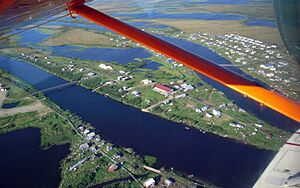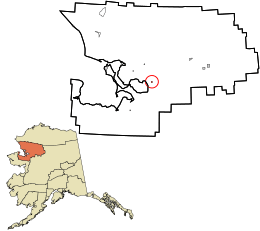Selawik, Alaska facts for kids
Quick facts for kids
Selawik
|
|
|---|---|

An aerial view of Selawik in 2010
|
|

Location in Northwest Arctic Borough and the state of Alaska.
|
|
| Country | United States |
| State | Alaska |
| Borough | Northwest Arctic |
| Incorporated | 1977 |
| Area | |
| • Total | 2.94 sq mi (7.62 km2) |
| • Land | 2.33 sq mi (6.04 km2) |
| • Water | 0.61 sq mi (1.59 km2) |
| Elevation | 0 ft (0 m) |
| Population
(2020)
|
|
| • Total | 809 |
| • Density | 347.06/sq mi (133.99/km2) |
| Time zone | UTC-9 (Alaska (AKST)) |
| • Summer (DST) | UTC-8 (AKDT) |
| ZIP code |
99770
|
| Area code | 907 |
| FIPS code | 02-68230 |
| GNIS feature ID | 1413930 |
Selawik is a small city in Northwest Arctic Borough, Alaska, United States. It is located in a northern part of Alaska. In 2020, about 809 people lived there. The name "Selawik" comes from the Iñupiaq words Siiḷivik or Akuliġaq. It means "place of sheefish," which are a type of fish found in the area.
Contents
Geography and Location
Selawik is located where the Selawik River flows into Selawik Lake. This spot is about 112 kilometers (70 miles) southeast of Kotzebue. The city is also very close to the Selawik National Wildlife Refuge. This refuge is a special protected area. It is a breeding and resting place for many types of birds that migrate.
According to the United States Census Bureau, the city covers a total area of 7.62 square kilometers (2.94 square miles). Most of this area, 6.04 square kilometers (2.33 square miles), is land. The rest, 1.59 square kilometers (0.61 square miles), is water.
Population and People
Selawik first appeared in the U.S. Census in 1880. It was listed as an Inuit village called "Selawigamute." At that time, 100 Inuit people lived there. The city was officially incorporated in 1963.
| Historical population | |||
|---|---|---|---|
| Census | Pop. | %± | |
| 1880 | 100 | — | |
| 1920 | 274 | — | |
| 1930 | 227 | −17.2% | |
| 1940 | 239 | 5.3% | |
| 1950 | 273 | 14.2% | |
| 1960 | 348 | 27.5% | |
| 1970 | 429 | 23.3% | |
| 1980 | 535 | 24.7% | |
| 1990 | 596 | 11.4% | |
| 2000 | 772 | 29.5% | |
| 2010 | 829 | 7.4% | |
| 2020 | 809 | −2.4% | |
| U.S. Decennial Census | |||
In 2000, there were 772 people living in Selawik. Most of the people, about 94.82%, were Native American. About 48.1% of the population was under 18 years old. The average age in the city was 19 years.
History of Selawik
The village of Selawik was first reported in the 1840s. A Russian naval officer named Lt. Lavrenty Zagoskin mentioned it as "Chilivik." Later, in 1880, a census study counted 100 "Selawigamute" people living there.
Around 1908, Selawik had a small wooden schoolhouse and a church. Over time, the village grew. Today, it has expanded across the Selawik River. Different parts of the city are connected by bridges.
Education in Selawik
The main school in Selawik is the Davis-Ramoth Memorial School. It is managed by the Northwest Arctic Borough School District. As of 2017, about 270 students attended the school. Most of these students were Alaska Natives.
See also
 In Spanish: Selawik (Alaska) para niños
In Spanish: Selawik (Alaska) para niños

